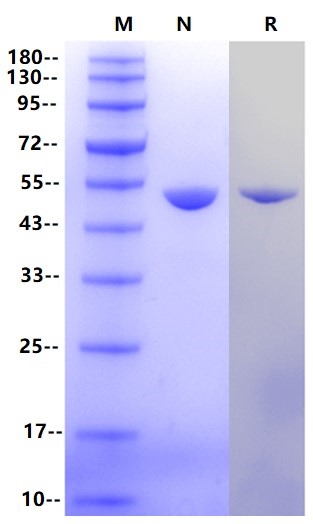MHHHHHHDDDDKSIEKIWAREILDSRGNPTVEVDLYTAKGLFRAAVPSGASTGIYEALELRDGDKQRYLGKGVLKAVDHINSTIAPALISSGLSVVEQEKLDNLMLELDGTENKSKFGANAILGVSLAVCKAGAAERELPLYRHIAQLAGNSDLILPVPAFNVINGGSHAGNKLAMQEFMILPVGAESFRDAMRLGAEVYHTLKGVIKDKYGKDATNVGDEGGFAPNILENSEALELVKEAIDKAGYTEKIVIGMDVAASEFYRDGKYDLDFKSPTDPSRYITGDQLGALYQDFVRDYPVVSIEDPFDQDDWAAWSKFTANVGIQIVGDDLTVTNPKRIERAVEEKACNCLLLKVNQIGSVTEAIQACKLAQENGWGVMVSHRSGETEDTFIADLVVGLCTGQIKTGAPCRSERLAKYNQLMRIEEELGDEARFAGHNFRNPSVL
48.7kDa(Reducing)
Reconstitute at less than 1 mg/mL according to the size in ultrapure water after rapid centrifugation .
Neuron-specific enolase (neuron-specific enolase, NSE) is one of the enolases involved in glycolysis, which exists in nerve tissue and neuroendocrine tissue. The activity of NSE in brain tissue was the highest, the activity level of peripheral nerve and neurosecretory tissue was in the middle, and the lowest value was found in non-nerve tissue, serum and spinal fluid. It has been found to be a tumor marker of lung cancer and neuroblastoma and can be used for differential diagnosis, disease monitoring, curative effect evaluation and recurrence prediction. Monitoring the recurrence of small cell lung cancer with neuron-specific enolase is 4-12 weeks earlier than the clinical determination of recurrence. Neuron-specific enolase can also be used in the differential diagnosis of neuroblastoma and nephroblastoma. The former increases abnormally while the latter does not increase significantly. Increase: seen in small cell lung cancer, neuroblastoma, neuroendocrine cell tumors (such as pheochromocytoma, islet cell tumor, melanoma) and so on.
